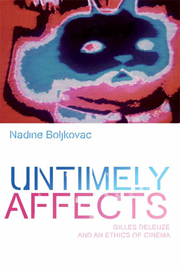4 - Mad Love
Published online by Cambridge University Press: 05 September 2013
Summary
The nature of emotion as pure element … in fact precedes all representation, itself generating new ideas. It does not have, strictly speaking, an object, but merely an essence that spreads itself over various objects, animals, plants and the whole of nature.
(B: 110)From its foreboding first strains and the black and white still image of a deserted airport pier, La Jetée's cumulative audio-visual-tactile image, a free indirect discourse and vision (see C2, ch. 7) overwhelms both screen and viewer as it evokes an experience akin to its music – that which is ever-new and of ‘great variety … unexpected progressions, and expressive of every motion, and accent; almost savage in strength and spirit at times, but more often melancholy’. Perhaps the most renowned and arguably most beautiful of Marker's several films and multi-media works, La Jetée (1962) derives its multi-sensory passionate force from its aura or essence, a particular thisness or sensual singularity that ‘pierces’ and wounds a body. As its contemplation of experience in an often intolerable world profoundly calls upon the senses, this short film imagines an emancipatory freedom or potential beyond our bodies' corporeal, fragile human suffering through the most productive and creative means possible. Via a vibrating screen that expresses itself synaesthetically through its details, traces and essence that are not bound to characters or subjectivities but affect and are affected by other bodies in this Spinozian sense, La Jetée newly discovers sensations of happiness, peace and sadness, intangibles at once so elusive and yet tactile.
- Type
- Chapter
- Information
- Untimely AffectsGilles Deleuze and an Ethics of Cinema, pp. 91 - 112Publisher: Edinburgh University PressPrint publication year: 2013



